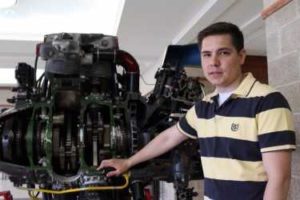(Above) The National Science Foundation grant supported an event that brought John Herrington, the first enrolled Native American (Chickasaw) to fly in space, to the College of Menominee Nation and UW–Madison over a three-day visit. Herrington (back row, third from left) met with students and shared his inspirational journey from childhood to his eventual career at NASA and the mission to the International Space Station. BRIAN NUNEZ, COLLEGE OF ENGINEERING’S DIVERSITY AFFAIRS OFFICE.
The College of Menominee Nation and the University of Wisconsin–Madison have had a close relationship for many years.
Now, the National Science Foundation and Directorate of Engineering is helping them take that relationship to the next level with funding through the Tribal Colleges and Universities Program.
The $1 million grant—the second to CMN and UW–Madison—will enhance their existing collaboration and support the development of high-quality engineering education, research and outreach.
The College of Menominee Nation, with a main campus in Keshena, Wisconsin, and an urban campus in Green Bay, is one of just 37 tribal colleges and universities nationwide. It began in 1993, in borrowed or rented facilities, offering general education classes to a cohort of just 42 students. By 2014, CMN had grown to offer various bachelor’s degrees, associate’s degrees, and certifications to its 560 enrolled students.
Currently, there are approximately 20 students in the CMN pre-engineering program. That might seem like a small number—but since fewer than 1 percent of practicing engineers are American Indians, increasing the number of American Indian engineering students is one goal of the CMN/UW-Madison partnership.
The TCUP funding fosters further growth; a first grant in 2010 established the pre-engineering infrastructure for CMN with two key components: building labs, and developing course transfer agreements. This first grant phase has enabled CMN to add much-needed state-of-the-art chemistry and physics lab facilities.

Other work under that first grant ensured that all of the fundamental engineering courses — chemistry, calculus, physics, biology, etc. — taught at CMN transfer, so that students who wish to attend UW–Madison or other UW System schools can do so seamlessly. Because UW–Madison has stringent course transferability standards, all of these fundamental courses will transfer to most universities across the nation. The grant has also funded students’ attendance at the two-day national conference of the American Indian Science and Engineering Society and other student development programs.
The latest TCUP grant will build on these efforts. The second grant is focused on research, evaluation and dissemination. The research component aims to better understand the opportunities and challenges for American Indian students choosing an engineering education.
“We are excited to continue our partnership with CMN so that together we can support and encourage all students’ efforts to pursue education in STEM disciplines, which rely heavily on the contributions of people with diverse backgrounds, perspectives and skills,” says UW–Madison College of Engineering Dean Ian Robertson. “This funding provides us a unique opportunity to engage the American Indian community in Wisconsin and provide a pathway to careers in science and engineering careers for people traditionally underrepresented in those fields.”
Chelsey LaTender, a student who participated in the pre-engineering program at CMN, is taking advantage of the unique opportunity offered by the TCUP grant. In spring 2017, LaTender transitioned from CMN to UW–Madison to study nuclear engineering. She says that the pre-engineering program at CMN prepared her for success by allowing her to take math, science, and engineering courses in a more intimate class environment, which helped her get a solid grasp on the material and become more confident in her abilities.
“Before the program I was not confident in my math skills, but once I started taking the more advanced math, I learned that I enjoyed math and science,” she says. “If the collaboration did not exist, I do not think I would be attending UW-Madison or be studying to be an engineer.” — Chelsey LaTender
Apart from being an incubator for American Indian students at CMN, the TCUP grant supports initiatives that advance the community of American Indian students at UW–Madison as well. For example, students already studying at UW–Madison can mentor students who matriculated at CMN and then transferred to Madison. Such connections promote a successful transition for CMN students and provide an opportunity for lasting relationships.
In November 2016, grant funding supported an event that brought John Harrington, the first enrolled member of an American Indian tribe (Chickasaw) to fly in space, to CMN and to UW–Madison. Harrington shared his story of his early life as a member of Chickasaw nation, and his eventual career at NASA and spaceflight on the International Space Station.
And in spring 2017, the grant supported a cross-campus event on environmental sustainability in which the UW–Madison College of Engineering hosted Sandra Begay, a Navajo Nation member and principal engineer at Sandia National Labs, along with a panel of leaders in environmental research and policy.
Events such as these provide all community members access to high-profile role models and help students – particularly American Indian students – see that their career goals are attainable.